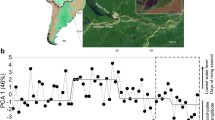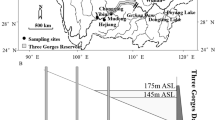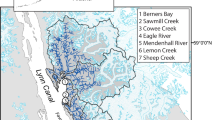Abstract
Over-abstraction of water places unsustainable pressures on river ecosystems, with the impacts amplified under drought conditions. Freshwater fishes are particularly vulnerable due to associated changes in water quality, and habitat availability, condition and connectivity. Accordingly, fish assemblages are ideal indicators of the impacts of drought and over-abstraction. The Murray-Darling Basin (MDB), south-eastern Australia, terminates at the Ramsar listed Coorong and Lower Lakes, which comprise Lake Alexandrina and Lake Albert. Over-abstraction and extreme drought during the last decade has placed these lakes under severe environmental stress. The purpose of this study was to investigate shifts in fish assemblages caused by substantial water level recession and salinization in the Lower Lakes. Small-bodied fish assemblages were sampled at the beginning and several years into the drought. Off-lake habitats held diverse fish assemblages in 2003, but most sites were dry by 2009. Remaining habitats were disconnected, salinities increased substantially, and aquatic vegetation shifted from freshwater to salt-tolerant species. There was a substantial decline in the proportion of specialist species, especially diadromous and threatened species, and an emerging dominance of generalist freshwater and estuarine species. The findings warn of the inevitable ecological impact of over-allocating water for human use in drought-prone regions, and highlight the need for adequate environmental water allocations. This study also emphasises that understanding the ecological attributes of a fish species, and the subsequent assignment to a functional group, will help predict vulnerability to decline and extirpation.







Similar content being viewed by others
References
Adams, M., S. D. Wedderburn, P. J. Unmack, M. P. Hammer & J. B. Johnson, 2011. Use of congeneric assessment to reveal the linked genetic histories of two threatened fishes in the Murray-Darling Basin, Australia. Conservation Biology 25: 767–776.
Albanese, B., P. L. Angermeier & J. T. Peterson, 2009. Does mobility explain variation in colonisation and population recovery among stream fishes? Freshwater Biology 54: 1444–1460.
Aldridge, K. T., B. M. Deegan, S. Lamontagne, A. Bissett & J. D. Brookes, 2009. Spatial and Temporal Changes in Water Quality in Lake Alexandrina and Lake Albert During a Period of Rapid Water Level Drawdown. CSIRO Water for a Healthy Country National Research Flagship, Canberra.
Angermeier, P. L., 1995. Ecological attributes of extinction-prone species: loss of freshwater fishes of Virginia. Conservation Biology 9: 143–158.
Becker, A. & L. J. B. Laurenson, 2007. Seasonal and diel comparisons of the diets of four dominant fish species within the main channel and flood-zone of a small intermittently open estuary in south-eastern Australia. Marine and Freshwater Research 58: 1086–1095.
Becker, A. & L. J. B. Laurenson, 2008. Presence of fish on the shallow flooded margins of a small intermittently open estuary in south eastern Australia under variable flooding regimes. Estuaries and Coasts 31: 43–52.
Bein, R. & G. Ribi, 1994. Effects of larval density and salinity on the development of perch larvae (Perca fluviatilis L.). Aquatic Sciences 56: 97–105.
Bloomfield, A. L. & B. M. Gillanders, 2005. Fish and invertebrate assemblages in seagrass, mangrove, saltmarsh, and nonvegetated habitats. Estuaries 28: 63–77.
Bond, N. R., P. S. Lake & A. H. Arthington, 2008. The impacts of drought on freshwater ecosystems: an Australian perspective. Hydrobiologia 600: 3–16.
Chapman, P. & K. Warburton, 2006. Postflood movements and population connectivity in gambusia (Gambusia holbrooki). Ecology of Freshwater Fish 15: 357–365.
Collares-Pereira, M. J. & I. G. Cowx, 2004. The role of catchment scale environmental management in freshwater fish conservation. Fisheries Management and Ecology 11: 303–312.
Conallin, A. J., K. A. Hillyard, K. F. Walker, B. M. Gillanders & B. B. Smith, 2011. Offstream movements of fish during drought in a regulated lowland river. River Research and Applications 27: 1237–1252.
Connolly, R. M., 1994. A comparison of fish assemblages from seagrass and unvegetated areas of a southern Australian estuary. Australian Journal of Marine and Freshwater Research 45: 1033–1044.
Crook, D. A., W. M. Koster, J. I. Macdonald, S. J. Nicol, C. A. Belcher, D. R. Dawson, D. J. O’Mahony, D. Lovett, A. Walker & L. Bannam, 2010a. Catadromous migrations by female tupong (Pseudaphritis urvillii) in coastal streams in Victoria, Australia. Marine and Freshwater Research 61: 474–483.
Crook, D. A., P. Reich, N. R. Bond, D. McMaster, J. D. Koehn & P. S. Lake, 2010b. Using biological information to support proactive strategies for managing freshwater fish during drought. Marine and Freshwater Research 61: 379–387.
Dufrêne, M. & P. Legendre, 1997. Species assemblages and indicator species: the need for a flexible asymmetrical approach. Ecological Monographs 67: 345–366.
Eastburn, D., 1990. The river. In Mackay, N. & D. Eastburn (eds), The Murray. Murray-Darling Basin Commission, Canberra: 3–15.
Fluin, J., P. Gell, D. Haynes, J. Tibby & G. Hancock, 2007. Palaeolimnological evidence for the independent evolution of neighbouring terminal lakes, the Murray Darling Basin, Australia. Hydrobiologia 591: 117–134.
Fratto, Z. W., V. A. Barko & J. S. Scheibe, 2008. Development and efficacy of a bycatch reduction device for Wisconsin-type fyke nets deployed in freshwater systems. Chelonian Conservation and Biology 7: 205–212.
Gill, H. S. & I. C. Potter, 1993. Spatial segregation amongst goby species within an Australian estuary, with a comparison of the diets and salinity tolerance of the two most abundant species. Marine Biology 117: 515–526.
Hammer, M. P., P. J. Unmack, M. Adams, J. B. Johnson & K. F. Walker, 2010. Phylogeographic structure in the threatened Yarra pygmy perch Nannoperca obscura (Teleostei: Percichthyidae) has major implications for declining populations. Conservation Genetics 11: 213–223.
Kingsford, R., K. Walker, R. Lester, P. Fairweather, J. Sammut & M. Geddes, 2011. A Ramsar wetland in crisis—the Coorong, Lower Lakes and Murray Mouth, Australia. Marine and Freshwater Research 62: 255–265.
Lake, P. S. & N. R. Bond, 2007. Australian futures: freshwater ecosystems and human water usage. Futures 39: 288–305.
Lasne, E., B. Bergerot, S. Lek & P. Laffaille, 2007. Fish zonation and indicator species for the evaluation of the ecological status of rivers: example of the Loire Basin (France). River Research and Applications 23: 877–890.
Lévêque, C., T. Oberdorff, D. Paugy, M. L. J. Stiassny & P. A. Tedesco, 2008. Global diversity of fish (Pisces) in freshwater. Hydrobiologia 595: 545–567.
Lintermans, M., 2007. Fishes of the Murray-Darling Basin: An Introductory Guide. Murray-Darling Basin Commission, Canberra.
Lucas, M. C. & E. Baras, 2001. Migration of Freshwater Fishes. Blackwell Science, Oxford.
Lui, L. C., 1969. Salinity tolerance and osmoregulation of Taeniomembras microstomus (Gunther, 1861) (Pisces: Mugiliformes: Atherinidae) from Australian salt lakes. Australian Journal of Marine and Freshwater Research 20: 157–162.
Magalhães, M. F., P. Beja, I. J. Schlosser & M. J. Collares-Pereira, 2007. Effects of multi-year droughts on fish assemblages of seasonally drying Mediterranean streams. Freshwater Biology 52: 1494–1510.
Matthews, W. J., 1998. Patterns in Freshwater Fish Ecology. Chapman and Hall, New York.
McCune, B. & M. J. Mefford, 2002. PC-ORD. Multivariate Analysis of Ecological Data, Version 4.36. MjM Software Design, Oregon
McCune, B. & J. B. Grace, 2002. Analysis of Ecological Communities. MjM Software, Oregon.
Molsher, R. L., M. C. Geddes & D. C. Paton, 1994. Population and reproductive ecology of the small-mouthed hardyhead Atherinosoma microstoma (Günther) (Pisces: Atherinidae) along a salinity gradient in the Coorong, South Australia. Transactions of the Royal Society of South Australia 118: 207–216.
Ormerod, S. J., 2009. Climate change, river conservation and the adaptation challenge. Aquatic Conservation: Marine and Freshwater Ecosystems 19: 609–613.
Potter, I. C., W. Ivantsoff, R. Cameron & J. Minnard, 1986. Life cycles and distribution of atherinids in the marine and estuarine waters of southern Australia. Hydrobiologia 139: 23–40.
Puckridge, J. T., K. F. Walker & J. F. Costello, 2000. Hydrological persistence and the ecology of dryland rivers. Regulated Rivers: Research and Management 16: 385–402.
Rehage, J. S., B. K. Barnett & A. Sih, 2005. Foraging behaviour and invasiveness: do invasive Gambusia exhibit higher feeding rates and broader diets than their noninvasive relatives? Ecology of Freshwater Fish 14: 352–360.
Shiel, R. J., K. F. Walker & W. D. Williams, 1982. Plankton of the Lower River Murray, South Australia. Australian Journal of Marine and Freshwater Research 33: 301–327.
Sim, T., L. Potts, M. Hammer & J. Doube, 2000. Fishes. In Strathalbyn Naturalists Club (ed.), Natural History of Strathalbyn and Goolwa Districts. Douglas Press, Woodville North, SA: 97–108
Smith, B. B., A. Conallin & L. Vilizzi, 2009. Regional patterns in the distribution, diversity and relative abundance of wetland fishes of the River Murray, South Australia. Transactions of the Royal Society of South Australia 133: 339–360.
Tonkin, Z., A. J. King & J. Mahoney, 2008. Effects of flooding on recruitment and dispersal of the Southern Pygmy Perch (Nannoperca australis) at a Murray River floodplain wetland. Ecological Management and Restoration 9: 196–201.
Walker, K. F., 2006. Serial weirs, cumulative effects: the Lower River Murray, Australia. In Kingsford, R. (ed.), The Ecology of Desert Rivers. Cambridge University Press, Cambridge: 248–279.
Ward, J. V., K. Tockner & F. Schiemer, 1999. Biodiversity of floodplain river ecosystems: ecotones and connectivity. Regulated Rivers: Research and Management 15: 125–139.
Wedderburn, S. & M. Hammer, 2003. The Lower Lakes Fish Inventory: Distribution and Conservation of Freshwater Fishes of the Ramsar Convention Wetland at the Terminus of the Murray Darling Basin, South Australia. Native Fish Australia (SA), Adelaide
Wedderburn, S. D., K. F. Walker & B. P. Zampatti, 2007. Habitat separation of Craterocephalus (Atherinidae) species and populations in off-channel areas of the lower River Murray, Australia. Ecology of Freshwater Fish 16: 442–449.
Wedderburn, S. D., K. F. Walker & B. P. Zampatti, 2008. Salinity may cause fragmentation of hardyhead (Atherinidae) populations in the River Murray, Australia. Marine and Freshwater Research 59: 254–258.
Williams, M. D. & W. D. Williams, 1991. Salinity tolerance of four species of fish from the Murray-Darling Basin River System. Hydrobiologia 210: 145–160.
Zampatti, B., C. Bice & P. Jennings, 2010. Temporal variability in fish assemblage structure and recruitment in a freshwater deprived estuary: The Coorong, Australia. Marine and Freshwater Research 61: 1298–1312.
Acknowledgments
The 2003 component of this study was supported by the South Australian Catchment Water Management Board, the Department for Environment and Heritage, The Goolwa to Wellington Local Action Planning Board and Native Fish Australia (SA). Data for several sites were supplied by Jason Higham, formerly of SARDI Aquatic Sciences. The 2008–2009 component of this study was funded by the Murray-Darling Basin Authority’s The Living Murray program through the South Australian Murray-Darling Basin Natural Resources Management Board, and was managed by Adrienne Frears. Field assistance was by Brian Degger and Thomas Barnes. Sampling was conducted in accordance with the University of Adelaide’s Animal Ethics Policy and the Fisheries Management Act 2007. The authors are grateful to Professor Angela Arthington and two anonymous reviewers for their very helpful comments.
Author information
Authors and Affiliations
Corresponding author
Additional information
Handling editor: M. Power
Rights and permissions
About this article
Cite this article
Wedderburn, S.D., Hammer, M.P. & Bice, C.M. Shifts in small-bodied fish assemblages resulting from drought-induced water level recession in terminating lakes of the Murray-Darling Basin, Australia. Hydrobiologia 691, 35–46 (2012). https://doi.org/10.1007/s10750-011-0993-9
Received:
Revised:
Accepted:
Published:
Issue Date:
DOI: https://doi.org/10.1007/s10750-011-0993-9




